|
| |
FFESTINIOG
RAILWAY ROLLING STOCK
- 24" narrow gauge -
TRS2004
/ TRS2006 & T2009 / TS2010 (where stated) |
|
Models
by
KEVIN
MARTIN
&
Reskins by BEN
KELLY &
Some
TS2009/2010 updates by
BELKENN |
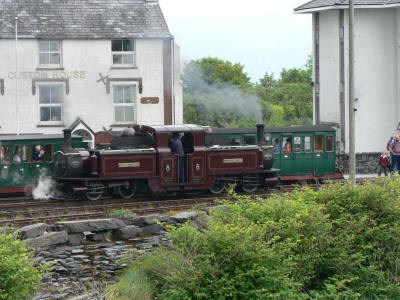
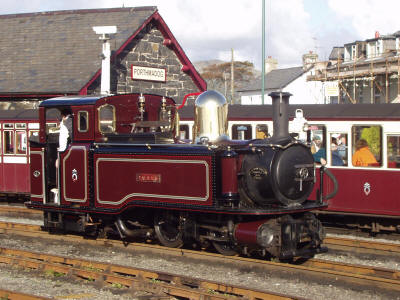
(pick on
thumbnail for larger picture) |
|
|
The Ffestiniog Railway was built in 1836
as a means of transporting slate from the Salte quarries at
Blaenau Ffestiniog to the coast at Porthmadog for export around
the world by ship (many being built in Porthmaddog). For many
years the line was a horse drawn affair but due to the success
of the railway and quarries soon struggled to cope with the
rapid increase in traffic. This was overcome by the introduction
of 4 Steam locomotives in 1863 (Princess, Prince, Mountaineer
and Palmerston). This was the first use of steam power on a 2ft
gauge line. Steam hauled passenger trains were introduced soon
after in the same year. The line continued to be succesful and
in a short time again struggled to cope with the traffic. This
was solved by the introduction of an articualted locomotive, the
double fairlie type loco "Little Wonder". This, again, was a
first for the railway being the first successful articualted
loco built. As Traffic increased more locos were aquired, the
last few actually being built at the Railways Boston Lodge
works.
Slowly, the slate traffic began to decline, followed by the
number of passengers. An association with the nearby Welsh
Higland Railway in the 1920's-30's did not help matters.
Passenger trains finally ceased at the start of World War II in
1939.The railway limped on through the war as a slate carrier,
but finally closed in 1946.
Following the succesful pioneering preservation activities on
the nearby Talyllyn Railway in 1951, attention was turned to the
Ffestiniog and this was reopened by enthusiasts in 1954. Since
then the railway has been very succesful and is one of the
leading Tourist attractions in Wales. The Ffestiniog is also
responsibile for the rebuilding of the nearby Welsh Highland
railway which should link up with the Ffestiniog rly at
Porthmadog in 2009.
Kevin Martin
|
|
|
|
|
Models
by
Kevin Martin
All models can be
used in TRAINZ TRS2004 and TRS2006
(Some TS2009/TS2010
updates
by
Belkenn)
(pick on thumbnail for
larger picture) |
|
Locomotives .....
Wagons / Coaches .....
|
Steam engine sounds
Steam engine sounds file
required for the following steam locomtoives
 |
Merddin Emrys,
|
 |
WHR Garratt 143
|
 |
Moel Tryfan,
|
 |
Linda, Blanche,
|
 |
Welsh Pony, Little Giant.
|
 |
Prince, Palmerston
|
 |
Stanhope,
|
 |
Taliesin
|
|
steam_sound_files_for_festiniog_railway_locos.cdp
(3.5
Mb)
required for TRS2004
& TRS2006
ffestiniog_rly_soundfile.cdp
(3.5
Mb)
required for TRS2009
& TRS2010 ONLY |
|
|
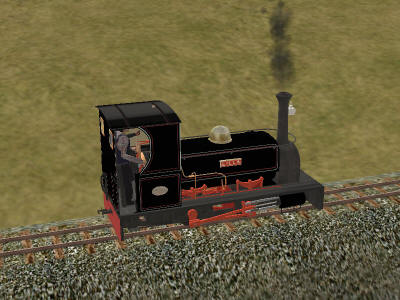
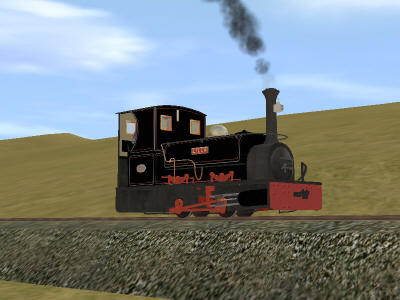
hunslett _locomotive_lilla.cdp (1.7
Mb)
TRS2004 / TRS2006
lilla.cdp (1.7
Mb)
TS2009 / TS2010
update
Lilla
Lilla was built in 1891 by the Hunslett Engine
Company for use at the Cilgwyn Quarries near Nantlle, North
Wales. She was sold to the Penrhyn quarry in 1928 where she
worked until 1955. Lilla can now be found working on the
Ffestiniog Railway at Porthmadog, North Wales.
|
|
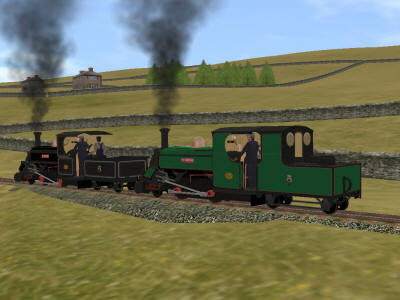
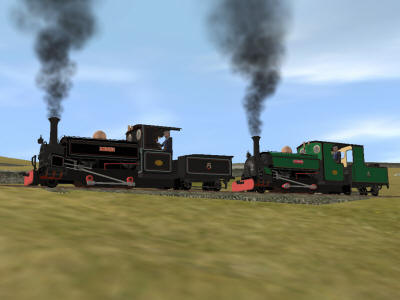
ffestiniog_rly_locomotives_linda_and_blanche.cdp (2.4
Mb)
TRS2004 / TRS2006
(TRS2004/06 Steam File download is also required - see top of
page )
blanche&linda.cdp
(3.2Mb)
TS2009 / TS2010
update
(TS2009/10 Steam File download is also required - see top of
page )
Ffestiniog
Rly Locomotives Linda and Blanche
This is a representation of the Locomotive
"Linda" as used on the Ffestiniog Rly, Porthmadog, North Wales.
In 1962 the FR faced an engine crisis among its own stock, and
hired Hunslet-built 0-4-0 saddle tank Linda from the Penrhyn
Quarries, which had recently closed its railway from the
quarries at Bethesda to Port Penrhyn, Bangor, on the North Wales
coast. Built in 1893, Linda was developed from the design of
Charles (1882), a close relative of locomotives built for the
Darjeeling Himalayan Railway in India; thus it is hardly
surprising that the engine proved well suited to the FR. Linda
was fitted with a new boiler in 1936.
By the end of 1963 the FR had purchased both Linda and sister
engine Blanche from Penrhyn. The two engines have undergone
extensive modifications to make them ideal Ffestiniog
workhorses; today they are superheated (by Hunslet in 1969),
oil-fired (1971) 2-4-0 saddle tanks with tenders carrying fuel.
In May 1993 the FR held a three-day Gala to celebrate the
Ladies' centenary. Linda re-entered traffic after overhaul in
October 1996, temporarily in Penrhyn black livery. For the
October 1996 Vintage Weekend Linda ran without a tender.
Blanche is Linda's sister from the Penrhyn Quarry Railway, and
like Linda was built in 1893 by Hunslet of Leeds, and re-boilered
in 1955 She arrived on the Ffestiniog Railway in 1963, a year
after her sister.
Since her arrival, Blanche has been fitted with piston valves
and a front pony truck to improve her weight distribution and
riding qualities (1972), and was given a new tender with half
cab in 1965.
After a major chassis overhaul, Blanche spent much of 1999 based
at the Welsh Highland Railway (Caernarfon), but has returned to
the FR and was in steam again after boiler repairs. She will be
in service for the 2002 season, before being withdrawn for major
10 year overhaul. |
|
|
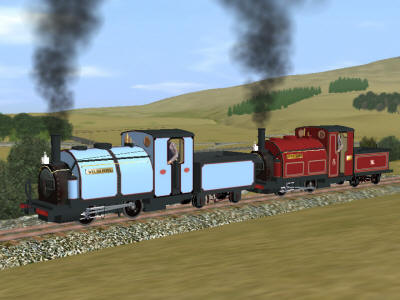
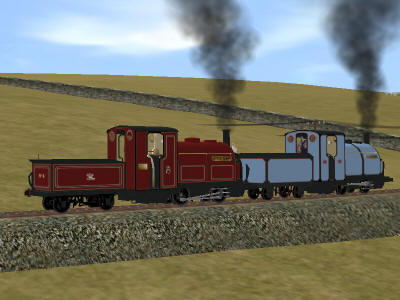
welsh_pony_little giant.cdp (2.8 Mb)
TRS2004 / TRS2006
(TRS2004/06 Steam File download is also required - see top of
page )
welsh_pony.cdp
(2.01Mb)
TS2009 / TS2010
update
(TS2009/10 Steam File download is also required - see top of
page )
2ft Gauge
Ffestiniog Locomotives "Welsh Pony & Little Giant"
Built by George England, in 1867, Welsh Pony is
an enlargement of the original four Festiniog engines, and were
saddle tanks from the start; the earlier engines were rebuilt to
similar condition.
Welsh Pony last worked in the 1930s, her boiler being condemned
in 1938. Previously, she had received major overhauls in 1891
and 1915. Today the engine is named bilingually, with a Merlen
Cymreig nameplate on one side. Welsh Pony was mounted on a
plinth outside Porthmadog Harbour station, but has been recently
removed for a little 'TLC', and is now stored under cover to
prevent further deterioration of her superstructure.
The locomotive is depicted as running in the early 1930's, with
a blue livery.
Built by George England, in 1867, Little Giant is an enlargement
of the original four Festiniog engines, and was as a saddle tank
engine from the start; the earlier Englan engines were rebuilt
to similar condition. Little Giant last worked in the 1932. |
|
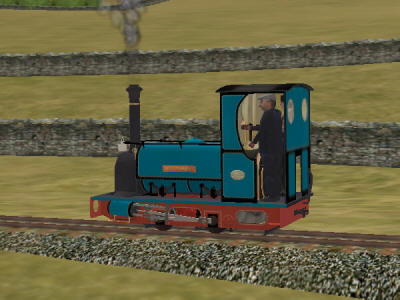
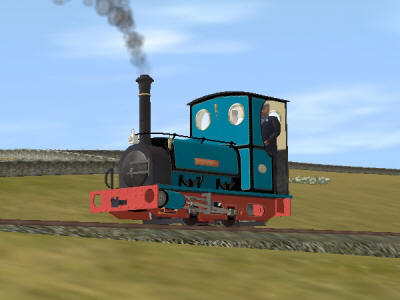 britomart.cdp (1.4
Mb)
TRS2004 / TRS2006
| Britomart
Britomart was built by the Hunslet Engine Company, Leeds in 1899
for the Pen-yr-Orsedd Quarry, North Wales. In 1965 Britomart was
bought for preservation and was first steamed on the FR in July
1966.
A major overhaul has just been completed (2007) and Britomart
visited the WHR(C) where it attended the "Join In" Weekend on
September 2007. |
|
|
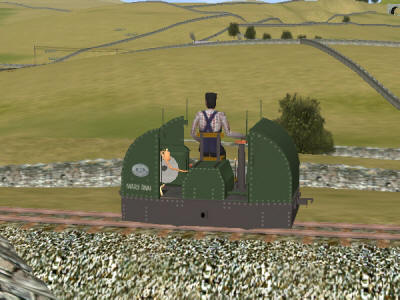
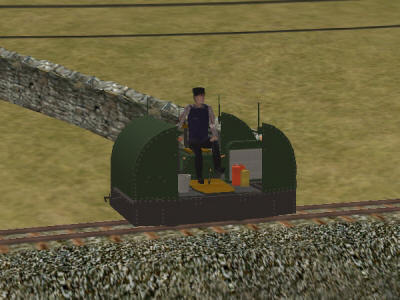
ffestiniog_railway_locomotive_mary_ann.cdp (0.6
Mb)
TRS2004 / TRS2006
maryann.cdp
(0.86 Mb)
TS2009 / TS2010
update
Ffestiniog
Railway Locomotive Mary Ann
Mary Ann was the first loco to work on the
revived Ffestiniog Railway in 1954. Mary Ann is a Simplex, built
by Motor Rail of Bedford in 1917 for service in World War 1, and
is one of a small number of survivors from that conflict. She
was purchased for the Ffestiniog and Welsh Highland Railways in
1923, and worked mainly as a shunting engine.
In 1955 Mary Ann hauled the first passenger services on the
reopened FR. A member of the engineering fleet she was
outclassed by later and more modern additions to the diesel
stable, but her historic importance was not forgotten and in the
1990's she was given a major overhaul, and returned to her
earlier appearance. The loco is modelled as she would have
appereared in the mid 1960's |
|
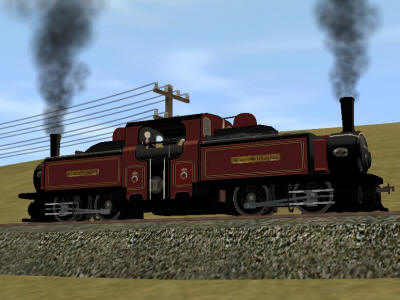
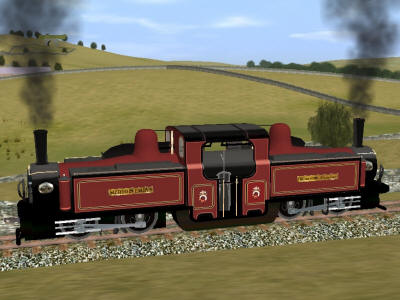
ffestiniog_rly_loco_merddin_emrys.cdp (0.7 Mb)
TRS2004 / TRS2006
(TRS2004/06 Steam File download is also required - see top of
page )
merrddin_emrys.cdp
(1.0Mb)
TS2009 / TS2010
update
(TS2009/10 Steam File download is also required - see top of
page )
Ffestiniog
Rly loco Merddin Emrys
The name is the Welsh equivalent of Merlin, and
continues the bardic tradition started with Taliesin. Merddin
was built in the FR's own Boston Lodge workshops, an indication
of the maturity the FR had reached. Merddin has been one of the
FR's mainstays for more than a century, and has changed shape
with successive rebuilds, major overhauls / rebuilds being
undertaken in 1895, 1921, 1934, 1961 and 1970. Its appearance as
seen here dates from a sponsored rebuild completed in 1988;
earlier manifestations since the FR was saved were less
pleasing, and reflected the fact that the loco, the last Fairlie
in service on the old FR, had been left where it stood in 1946,
and had deteriorated so badly that much had to be replaced. The
engine was converted to oil firing in 1972 and back to coal
firing in 2007. |
|
|
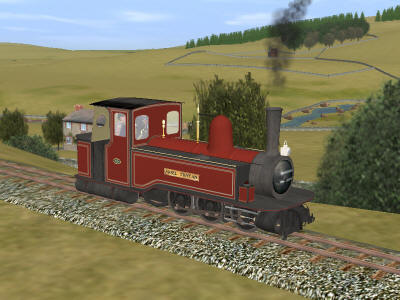
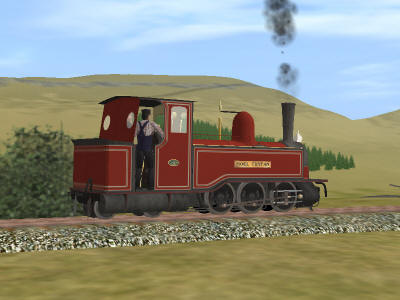
nwngr_locomotive_moel_tryfan.cdp (1.3 Mb)
TRS2004 / TRS2006
(TRS2004/06 Steam File download is also required - see top of
page )
moel_tryfan.cdp
(1.34Mb)
TS2009 / TS2010
update
(TS2009/10 Steam File download is also required - see top of
page )
NWNGR Locomotive Moel Tryfan
This is a representation of the NWNGR Locomotive "Moel Tryfan".
Built in 1875 (along with sister engine "Snowdon Ranger") by the
Vulcan Foundry for use on the North Wales Narrow Gauge Railway.
It was a single Fairlie 0-6-4 design. By 1917 both engines were
in very poor condition and the railway was not in the position
to be able to replace them. The problem was solved by combining
the best parts of both engines to make a "new" engine. This
engine retained the name Moel Tryfan. In 1923 it became part of
the WHR fleet and in 1924 it was cut down to enable it to run on
the Ffestiniog Rly. It ran in this condition until 1936 when it
was taken into Boston Lodge for repairs (which were never
carried out). Eventually, in 1954, the remaining parts of the
locomotive were scrapped. |
|
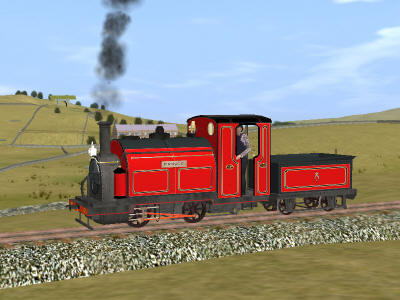
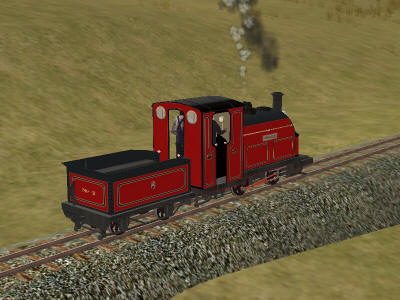
ffestiniog_rly_locomotive_prince.cdp (1.4 Mb)
TRS2004 / TRS2006
Ffestiniog
Rly locomotive Prince
This is a representation of the Locomotive
"Prince" which can be found on the narrow gauge Ffestiniog
Railway
based at Porthmadog, North Wales. It was built in 1863 and was
the first (alongside sister engine Princess) 2ft gauge steam
loco built. It is possibly one of the oldest steam locomotives
in the world still regularly working.
The model depicts Prince as currently running. |
|
|
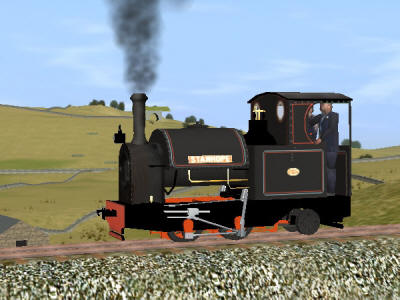
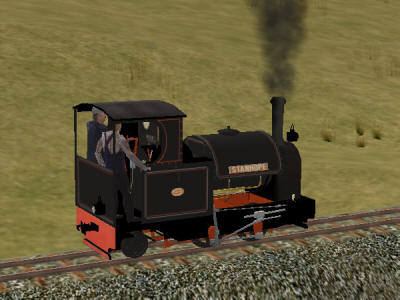
kerr stuart & co locomotive stanhope.cdp (1.1
Mb)
TRS2004 / TRS2006
(TRS2004/06 Steam File download is also required - see top of
page )
stanhope.cdp
(1.7Mb)
TS2009 / TS2010
update
(TS2009/10 Steam File download is also required - see top of
page )
Kerr Stuart
& Co locomotive Stanhope
Stanhope was manufactured in 1917 by Kerr Stuart
& Co. It was used for the construction of the Royal Dockyard at
Rossyth and afterwards also the Sidcup bypass. It was bought, in
1930, by the Durham County Water Board. It was used on the
Weardale reservoir contract, gaining the name "Stanhope" from a
local village. It then travelled to Penrhyn Quarry in North
Wales in 1934. Here it worked until 1948 when it became worn
out. Here it remained until it was bought for presevation in
1966. After many years the loco was finally returned to working
order by Alan Keef ltd. Ross on Wye.
The aim is to operate the locomotive at the new site of the
Moseley Railway Trust, however in the meantime it is based at
the West Lancashire Light Railway at Hesketh Bank, where it
arrived on 20th November 1999. |
|
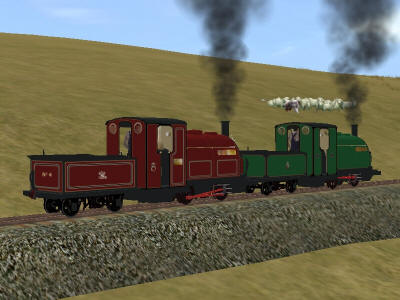
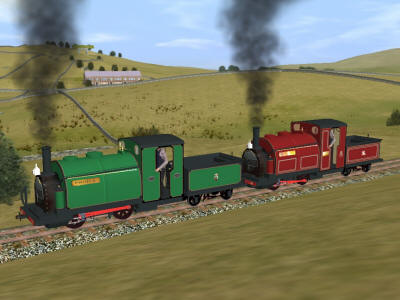
ffestiniog_rly_locos_prince_palmerston.cdp (2.8
Mb)
TRS2004 / TRS2006
(TRS2004/06 Steam File download is also required - see top of
page )
Ffestiniog
Rly locos Prince_Palmerston
This is a representation of the Ffestiniog Rly
Locomotives' No2 "Prince" and No 4 "Palmerston" as used on the
narrow gauge Ffestiniog Rly, Porthmadog, North Wales. They were
originally built in 1863/64 by George England & Co. Prince is
depicted as running in the mid 1950's.
his is a representation of the Ffestiniog Rly Locomotive No 4 "Palmerston"
as used on the narrow gauge Ffestiniog Rly, Porthmadog, North
Wales. It was originally built in 1864 by George England & Co.
It was finally withdrawn from service in 1940 when it used by
the old FR as a stationary boiler. The engine was bought by a
group of enthusiasts in the 1970s with a view to restoration to
working order. Palmerston eventually returned to steam in 1993.
Palmerston is still coal-fired and the engine is treated more as
a working museum piece rather than a loco for regular use.
|
|
|
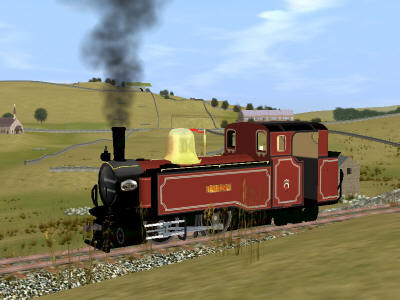
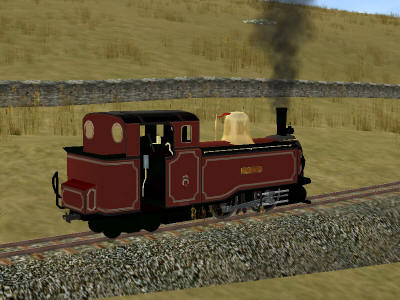
ffestiniog_railway_locomotive_taliesin.cdp (1.0
Mb)
TRS2004 / TRS2006
(TRS2004/06 Steam File download is also required - see top of
page )
taliesin.cdp
(1.35Mb)
TS2009 / TS2010
update
(TS2009/10 Steam File download is also required - see top of
page )
Ffestiniog
Railway Locomotive Taliesin
Ffestiniog Railway supporters long regretted the
disappearance of the Single Fairlie from FR metals, and their
support has led to the successful project to build a replacement
Taliesin, as a Single Fairlie along the lines of today's FR
Double Fairlies, and incorporating some parts surviving from the
original; on the basis of this the FR regards the "new" loco as
a rebuild of the first Taliesin. The pattern of funding by
covenant over a number of years has been followed by other
groups building new steam engines, notably the A1 Steam
Locomotive Trust - where the Ffestiniog leads, others follow!
The rebuilt loco was officially "born" in March 1996, when
volunteers erected its mainframe. Taliesin was first steamed on
April 11th 1999, and had its public launch at the May 1999 Gala,
where it was the star attraction, even though a few details were
not yet complete, and there had been no time to apply the lined
red livery.
The loco's first use after this was on Guest Driver duties,
followed by a relaunch, complete and in full livery, at the
October 1999 Vintage Weekend. Uniquely among FR locos, Taliesin
is designed to be converted straightforwardly to run on coal
instead of its usual oil fuel, and the authentic effect of the
loco was completed by the coal in the bunker at the Vintage
Weekend.
Following an extended period in the works for the completion of
various items, Taliesin entered public passenger service in late
August 2000, on the summer vintage Porthmadog to Tan-y-Bwlch
trains. |
|
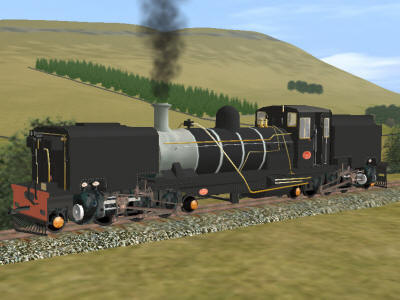
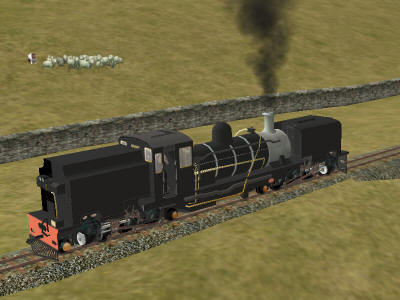
welsh highland rly garratt no 143.zip (1.8 Mb)
TRS2004 / TRS2006
(TRS2004/06 Steam File download is also required - see top of
page )
whr_garratt.cdp
(2.63Mb)
TS2009 / TS2010
update
(TS2009/10 Steam File download is also required - see top of
page )
Welsh
Highland Rly NGG16 Garratt no 143
The NGG16 class 2-6-2+2-6-2
Beyer-Garratts built for work in South Africa are amongst the
most powerful steam locomotives ever built for 2' gauge. Three
NGG16s are now in Wales, all from the same batch built by Beyer
Peacock in 1958. Closure of some 2' gauge lines in South Africa,
together with dieselisation of others, means that a considerable
quantity of rolling stock and other material has come onto the
market there. The WHR Project has taken full advantage of this
situation. However the Transnet Heritage Foundation in South
Africa has now placed a ban on further steam exports, meaning
that the railway may not be able to acquire nos. 139 and 142 at
a later date, as had been planned; however it is understood that
the ban only applies to unique survivors of a class, which
should not apply to the NGG16. Fortunately other suitable motive
power has been purchased in the meantime, in the form of two
NG15 locos which were already in the UK.
The contract to supply and overhaul the first two NGG16s for the
WHR, nos. 138 and 143, went to the Alfred County Railway in
South Africa. No. 143 was the last Garratt built by the
Manchester firm, and will make an interesting comparison with
pioneer K1. No. 138 was steamed in March 1996, with no.143
following over the summer. These NGG16s have been converted from
coal to oil firing, necessary in view of the risk of starting
lineside fires, particularly where the line will pass through
Forestry Commission land. |
|
|
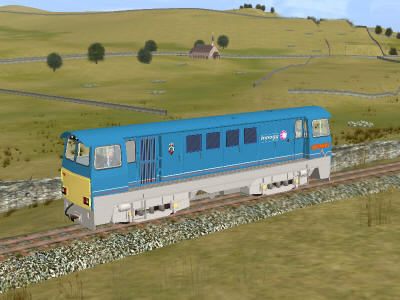
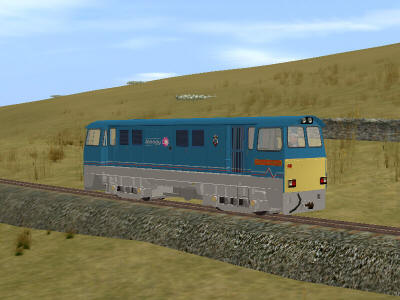
vale_of_ffestiniog.cdp (0.6
Mb)
TRS2004 / TRS2006
vale_of_ffestiniog 2.cdp
(0.65Mb)
TS2009 / TS2010
update
Vale of
Ffestiniog
This locomotive a 335 HP turbo-charged
diesel-hydraulic B-B built by Funkey of South Africa. Very much
more powerful than previous FR internal combustion units, the
Funkey provides an attraction in its own right as well as
reserve power able to handle the heaviest trains. The original
body was, however, far too large for the FR loading gauge, and
as a result the loco has received a new body with a cab at each
end. Work on this was done with the generous support of National
Power (now Innogy). The FR's loco carries a livery similar to
the Class 59's operated by the National Power Rail Unit at
Ferrybridge for the transport of coal and limestone to power
stations, while the name Vale of Ffestiniog is in keeping with
the names carried by the National Power locos, as well as
denoting the valley through which part of the FR runs. The
transformation of the Funkey into Vale of Ffestiniog was the
main part of the FR's participation in the 1997 Year of
Engineering Success campaign. |
|
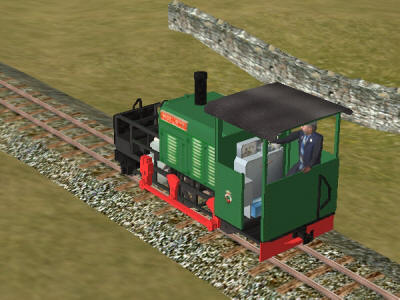
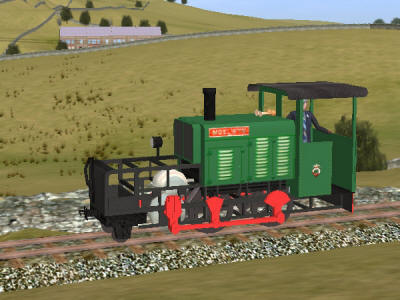
ffestiniog_rly_loco_moelwyn.cdp (0.7
Mb)
TRS2004 / TRS2006
Ffestiniog
Rly loco Moelwyn
Built by Baldwin of Philadelphia in 1918, Moelwyn
was made for service in WW1 for the French Army. She was
purchased second hand in 1925 for use on the Ffestiniog and
Welsh Highland Railways. In the early revival years, Moelwyn was
re-engined from petrol to diesel and was a valuable mainstay
both on engineering trains and as a back up passenger
locomotive. Carrier wheels were added at the front, making
Moelwyn a 2-4-0 and a more stable runner. The loco returned to
the FR in August 1998 after a lengthy restoration in England,
and now forms part of the Railway's heritage fleet. Her name was
derived from a typical FR play on words, "Moelwyn" being the
name of the mountain rising north of Tan y Bwlch; Moel means
bare hill, but can be read as bald, so FR "Welsh" gives the
translation of Baldwin! |
|
|
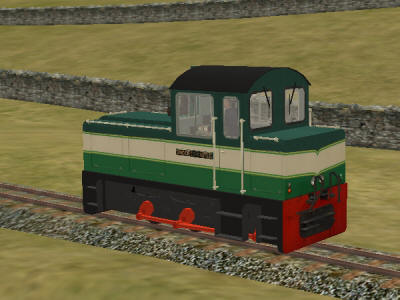
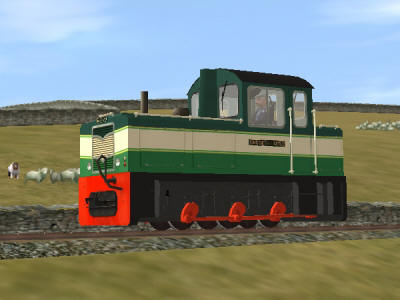
criccieth_castle_v2_(ffestiniog rly).cdp (0.9 Mb)
TRS2004 / TRS2006
Criccieth
Castle
Criccieth Castle is the youngest of the diesel
locomotive fleet. An 0-6-0, she was built at Boston Lodge from
parts bought from Baguley - Drewry, although much was built new.
The superstructure was designed "in House". Entering service in
1995, the loco sees regular service in the passenger fleet, and
is fitted with advanced computer controls which enables the use
of the push-pull system. This allows the engine to remain at the
top end of the train on "down" services, being driven from a cab
in observation carr. no. 111. |
|
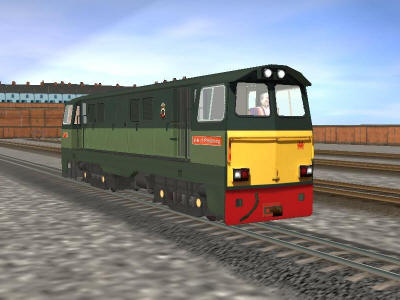
ffestiniog_railway_vale_of_ffestiniog.cdp (1.1 Mb) reskin by Tony (tmz06003)
tested in TRS2004
and TS2010
|
|
|
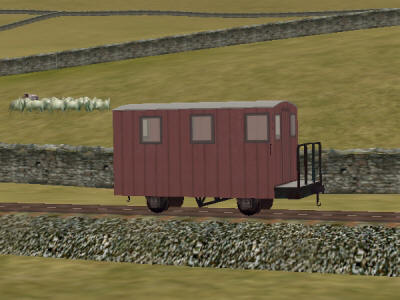
ffestiniog_railway_brakevan_no_2.cdp (0.2 Mb)
Ffestiniog
Railway Brakevan no 2
This is a representation of Brake Van No 2 as
used on the 2 ft gauge Ffestiniog Railway at Porthmadog , North
Wales.
|
|
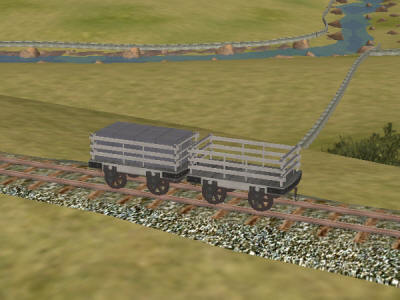
ffestiniog_rly_wood_slate_wagon(ind).cdp (0.2 Mb)
Ffestiniog
Rly Wood Slate Wagon(ind)
For use with Trainz 2004 + SP2 update only
This is a representation of a typical 2 ton wooden slate wagon
as used on the Ffestiniog Railway. This is a Trainz 2004
industry compatible model and suitable for use with the new
multiple industry facility available with the SP2 update. |
|
|
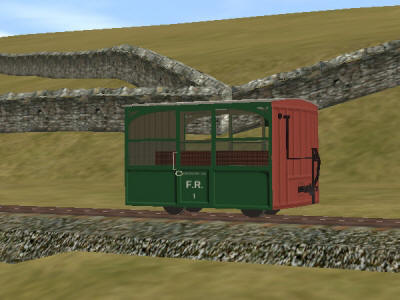
ffestiniog_rly_coach_no_1.cdp (0.5 Mb)
Ffestiniog
Rly Coach no 1
Built in 1996 by the FR Co. at Boston Lodge, No.
1 is a replica semi-open, single compartment coach with knife
board seats, incorporating parts from an earlier vehicle which
ran until 1970 as semi-open No. 6. That vehicle has now been
rebuilt to original, enclosed, first class condition and
numbered 2, the discarded components being used in this replica.
It was repainted in 2002 in the 1920's Col. Stevens livery. |
|
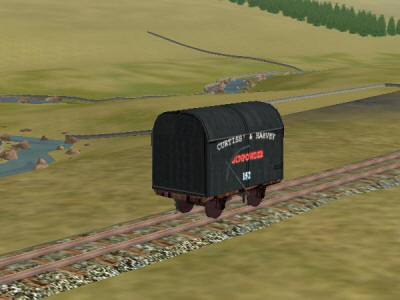
ffestiniog_rly_gunpowder_van.cdp (0.2 Mb)
Ffestiniog
Rly Gunpowder Van
This is a representation of the vans used to
transport gunpowder on the 2ft gauge Ffestiniog Railway from
Porthmadog to the slate quarries.
|
|
|
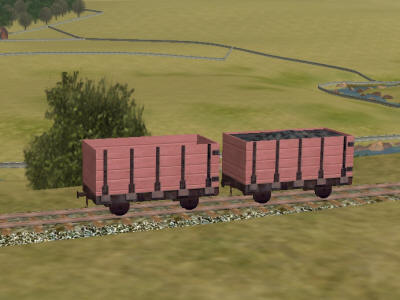
ffestiniog_rly_open_coal_wagons.cdp (0.5 Mb)
Ffestiniog
Railway Open Coal Wagons
This is a representation of an early style coal
wagons as used on the 2 ft gauge Ffestiniog Rly at Porthmadog,
North Wales. Both loaded and unloaded are depicted.
|
|
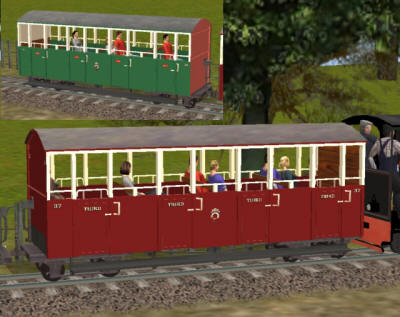
ffestiniog_rly_carriages_37_and_38.cdp (1.1mb)
|
Carriages 37 and 38
The
file consists of representations of both Ffestiniog Rly
carriages 37 and 38. Built in 1971 they are all 3rd class and
have a seating capacity of 32. They are both depicted as
currently running (2005). 37 is depicted in the standard maroon
and cream livery and 38 is depicted in the 1950's green and
ivory livery.
|
|
|
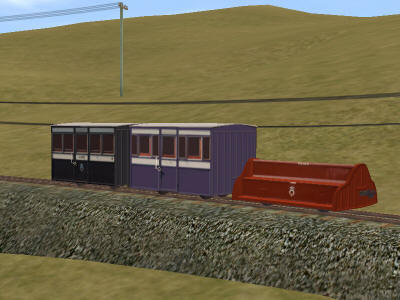
ffestiniog_rly_4_wheel_coachs_(set_a).cdp (0.7 Mb)
TRS2004 / TRS2006
the_flying_bench.cdp (0.24Mb)
TRS2009 and TRS2010
update
Ffestiniog
Railway 4-wheeled coaches (pack a)
These are a representation of Coaches No's 2,3
and the "The Flying Bench" as currently running on the
Ffestiniog Railway at Porthmadog, North Wales. They were built
in 1863/64 and were the first narrow gauge passenger carriages
in the world. |
|
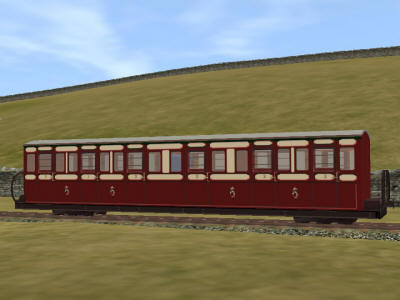
ffestiniog_rly_coach_nos_17_and_18.cdp (0.4 Mb)
Ffestiniog
Rly Coach nos 17 and 18
This is a representation of the 2ft gauge Bogie
Coaches No's 17 & 18 as used on the Ffestiniog Railway at
Porthmadog , North Wales. They were built in 1876 by Brown,
Marshalls and were designed by G.P. Spooner. They are depicted
in the current preservation livery of maroon and lt cream. |
|
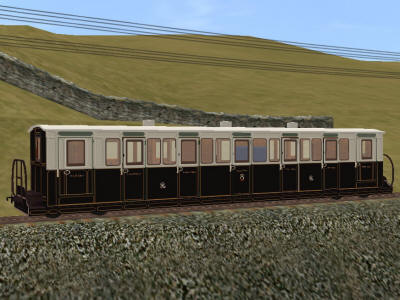
ffestiniog_rly_coach_no_15.cdp (0.4mb)
Ffestiniog
Rly coach no 15
This is a representation of coach no 15 as
currently running on the Ffestiniog Railway at Porthmadog, North
Wales.
No's 15 was built in 1872 to a design by C.E. Spooner. They were
first iron framed bogie coaches to be used in the United Kingdom
(and possibly the world). No 15 has recently been restored to
it's original splendid Victorian condition with the help of the
Heritage Lottery Fund.
This coach is SP2 compatible and features opening carriage doors
and passengers |
|
_b-800_small.jpg)
ffestiniog_rly_coach_no_18_(victorian_livery).cdp (0.7
Mb)
Ffestiniog
Rly Coach no 18 (Victorian Livery)
This is a representation of Bogie Coaches No 18
as used on the Ffestiniog Railway at Porthmadog , North Wales.
They were built in 1876 by Brown, Marshalls and were designed by
G.P. Spooner. This coach has just been restored ( September
2003) to it's original Victorian condition.
|
|
|
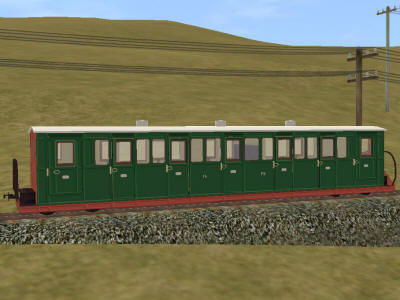
ffestiniog_rly_coach_no_16.cdp (0.3 Mb)
Ffestiniog
Rly Coach No 16
This is a representation of coach no 16 as
currently running on the Ffestiniog Railway at Porthmadog, North
Wales. No 16 was built in 1872 (alongside coach no 15) to a
design by C.E. Spooner. It was first iron framed bogie coaches
to be used in the United Kingdom (and possibly the world). No 16
has recently been restored to it's original splendid 1930's
condition with the help of the Heritage Lottery Fund.
|
|
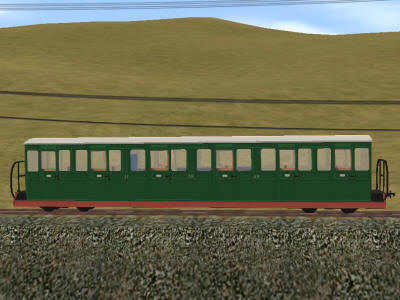
ffestiniog_railway_no_20_bogie_coach.cdp (0.4 Mb)
Ffestiniog
Railway No 20 Bogie Coach
This is a representation of Bogie Coach No 20 as
used on the Ffestiniog Railway at Porthmadog , North Wales. They
were built in 1876 by the Glouster Wagon co. and were designed
by G.P. Spooner. This coach is depicted in it's 1930's livery as
currently running on the railway (2004). |
|
|
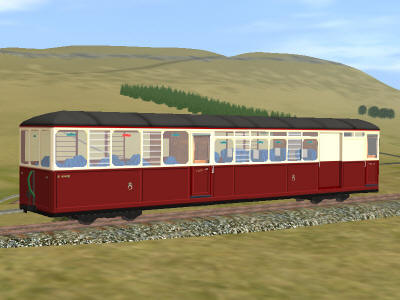
ffestiniog_rly_coach_no_100.cdp (0.7 Mb)
Ffestiniog
Rly coach no 100
You must already have coach 118 installed for
this coach to operate correctly.
This is a representation of observation coach no 100 as running
on the Ffestiniog Railway at Porthmadog, North Wales.
No 100 was built in 1965 by the Ffestiniog Railway in their
Boston Lodge works. It has a capacity of 18 seats, all 1st Class |
|
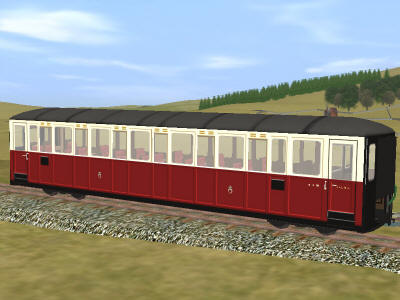
ffestiniog_rly_coach_no_118.cdp (0.3 Mb)
Ffestiniog
Rly Coach no 118
This is a representation of coach no 118 as
currently running on the 2ft gauge Ffestiniog Railway at
Porthmadog, North Wales.
No 118 was built in 1977 by the Ffestiniog Railway in their
Boston Lodge Works.
|
|
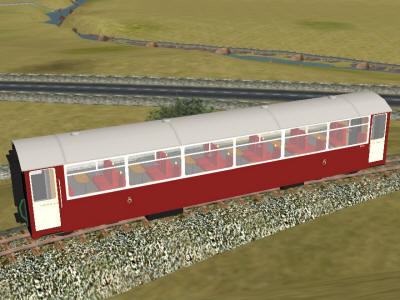
ffestiniog_rly_coach_no_122.cdp (0.4 Mb)
Ffestiniog
Rly Coach No 122
Coach 122 looks rather different to our other
rolling stock as it is designed to conform to various new health
and safety regulations. The coach has considerably more headroom
with high backed seats for a safer and comfier ride, and high
visibility handrails designed in such a way, that in the case of
sudden movemen. The coach also makes use of a new up to date
secondary suspension system, enhancing the passengers ride still
further. |
|
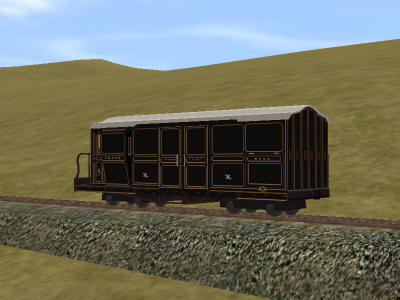
ffestiniog_rly_passenger_brakevan_no_1.cdp (0.4
Mb)
Ffestiniog
Rly Passenger Brakevan No 1
Please note that this is for use with TRS2004
+SP2 only.
Three passenger bogie brake vans were built for the railway
between 1873 and 1875. They were unusual in having a "curly"
roof outline. They consisted of a brake and baggage compartment
as well as having a compartment for dogs. No 1 (this model) was
built in April 1873
and was scrapped in 1921. No 2 was rebuilt in 1921 with 2
passenger compartments and is still in use today as coach 10. No
3 survived until the closure of the railway. |
|
|
|
Reskins by Ben
Kelly
All models can be
used in TRAINZ TRS2004 and TRS2006
unless otherwise noted
(pick on thumbnail for
larger picture) |
|
Locomotives .....
Wagons / Coaches .....
|
|
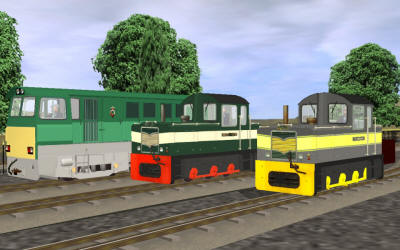
BK-diesels.cdp (2.5
Mb)
|
Diesels
This pack
contains representations of 'Vale of Ffestiniog', as currently
running in two-tone BR livery; 'Criccieth Castle' as running
since its repaint in 2007; and 'Harlech Castle', the railway's
principal works locomotive. Some artistic license is required
here as 'Harlech Castle' and 'Criccieth Castle' are related but
not actually identical. |
|
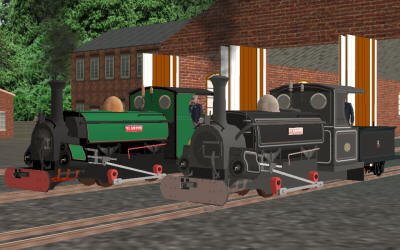
BK-ladies.cdp (7.7Mb)
(TRS2004 and TRS2006)
|
Ladies
This pack
contains representations of 'Linda' and 'Blanche' at earlier
stages in their FR careers; namely as an 0-4-0ST in black
Penrhyn livery and mismatched tender, and as a green 0-4-0ST.
The pack contains the same models for both Linda and Blanche. |
|
|
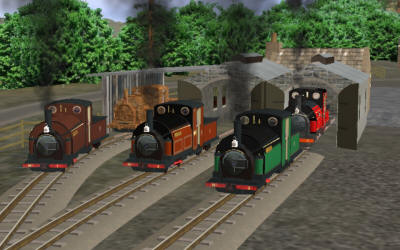
BK-englands.cdp (12.8 Mb)
|
Englands
This pack
contains FR no.1 'Princess' built in 1863, an unpowered 'scrap'
England engine model, and several different liveries for
'Prince'. These are Edwardian as worn c1910, green 1960s livery
and red 1980s livery. |
|
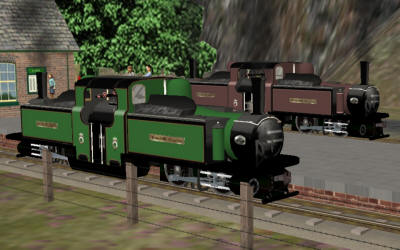
BK-merddins.cdp (4.6 Mb)
|
Merddins
These are
two representations of Double Fairlie Merddin Emrys, one as the
loco appeared i a run down state at closure in 1946 and the
other after overhaul in 1963. |
|
|
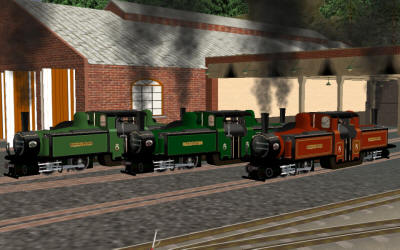
BK-LT.cdp (5.6
Mb)
|
LT
This pack
contains representations of the fourth double fairlie locomotive
to be built for the FR in 1886. This engine was first named
'Livingston Thompson' until 1932 when it was renamed 'Taliesin'
(the original Single Fairlie of this name having been scrapped
at about this time). It was under repair when the railway closed
in 1946 but was restored for service with the preserved railway
in 1956. In 1961 it was renamed again to 'Earl of Merioneth'
(not to be confused with the 1979 new double Fairlie of the same
name) but was withdrawn in 1971 to be replaced by the new build
Fairlie of the same name in 1979. The body languished about the
FR until 1988 when it was cosmetically restored for display
purposes. it also regained the original name 'Livingston
Thompson' at this time. It is currently on static display at the
NRM in York.
The pack
includes a 'Livingston Thompson', 'Taliesin' and 'Earl of
Merioneth' model. |
|
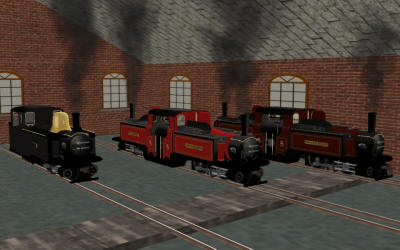
BK-fairlies.cdp (6.1
Mb)
|
Fairlies
A
representation of 'James Spooner', the second Double Fairlie to
be built for the FR. The locomotive is depicted in a condition
sometime after 1887 when a cab was fitted.
A
representation of David Lloyd George, the railway's newest
Double Fairlie built in 1992. The loco is depicted as currently
running.
A
representation of the Single Fairlie Taiesin as it rolled out of
the erecting shop in 1999 painted in unlined black livery. |
|
|
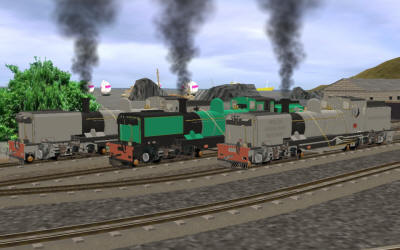
BK-ngg16s.cdp (7.6 Mb)
|
NGG16s
This pack
contains a representation of NGG16 Garratt 138 as currently
running on the Welsh Highland Railway, NGG16 87 with WHR
branding as outshopped in January 2009 and 87 unbranded as
delivered to Dinas in March 2009.
87 was
built in 1936 in Belgium, one of the first batch of NGG16s to be
built, as developed from the earlier NGG13 class. 87 spent its
working life in South Africa and was left to rot like so many
NGG16s when its line closed down. It came to the UK in 1998 and
arrived on the WHR in 2006. It was restored from derelict
condition at Boston Lodge and was outshopped in January 2009,
joining its sisters 138 and 143 at Dinas in March.
138 was
built in 1958 and also worked in South Africa. It entered
service on the newly built WHR in 1997 and was painted in its
current livery in 2001. |
|
|
|
|
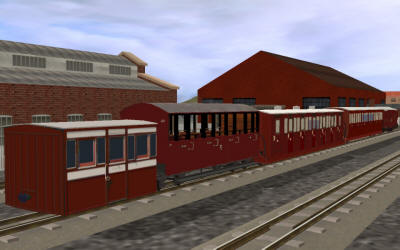
BK-10scarrs.cdp (1.9 Mb)
|
10scarrs
A
representation of Ffestiniog Railway carriages 3, 16, 20 and van
1 as they were painted during the Edwardian Period and also
during the 80s. Carriage 37 is included although it wasn't
around in the Edwardian period but it was in the 80s. |
|
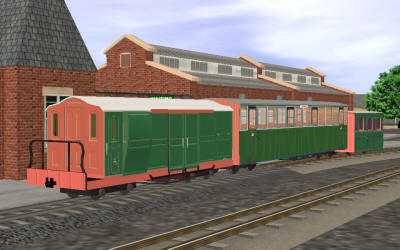
BK-30scarrs.cdp (1.2 Mb)
|
30scarrs
A
representation of Ffestiniog/Welsh Highland carriages 3, 25 and
Van 2 as they appeared during the 1930s when the two railways
were under the management of Colonel HF Stephens. |
|
|
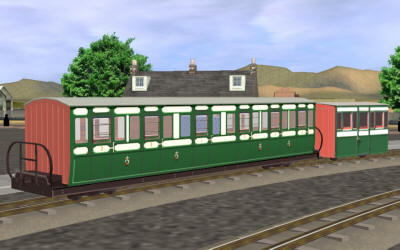
BK-50scarrs.cdp (0.6 Mb)
|
50scarrs
A
representation of Ffestiniog Railway carriages 17 and 3 as they
appeared in the 50s and 60s when such carriages were often used
as part of the 'Flying Flea' service. |
|
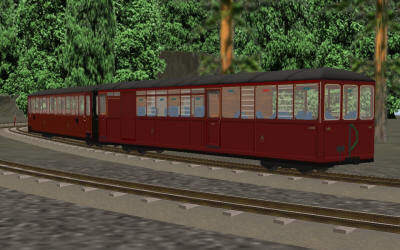
BK-10011880s.cdp (0.8 Mb)
|
10011880s
A
representation of carriages 100 and 118 as they appeared in the
late 70s and 80s in maroon livery. |
|
|
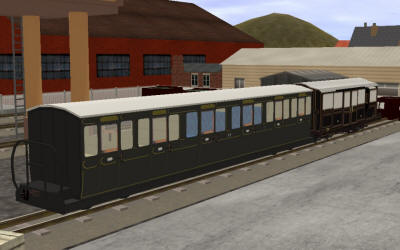
Bk-victcarrs.cdp (0.7 Mb)
|
Victcars
A
representation of Carriage 19 as currently running in Victorian
Livery, and also a representation of the original passenger
brake vans as built in 1873 in original livery. |
|
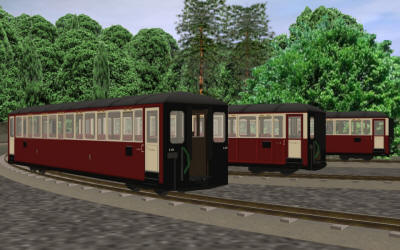
BK-newcarrs.cdp (0.6mb)
|
Newcarrs
A
representation of a Ffestiniog Railway modern carriage in a
livery as carried by ones on the Welsh Highland Railway, and in
the 'enhanced' livery carried by recently built or refurbished
carriages on the Ffestiniog Railway both with and without side
panels |
|
|
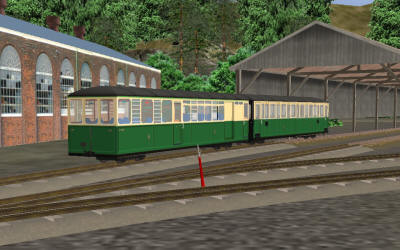
BK-pushpull.cdp (0.85 Mb)
|
Pushpull
A
representation of the push/pull carriages on the Ffestiniog
Railway as built in the early 1990s and in their original green
and cream livery. The observation carriage is used as a driving
trailer. |
|
|
|
 visits to this
page visits to this
page
|
